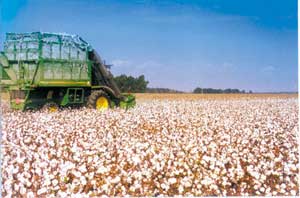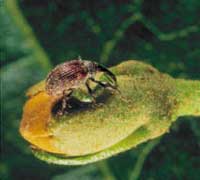Economic Benefits
 |
| Land grant universities conservatively estimate that a 10 percent yield increase can be expected after eradication of the boll weevil. |
- Southeastern land grant universities, which have studied eradication program economics extensively, conservatively estimate that weevils can cause a loss of 10 percent of expected yield in a cotton crop. Significantly greater yield losses occur where weevil infestations are historically high.
- In the Southeast, where the weevil has been eradicated, the combined annual direct economic benefits from increased yields, reduced insect damage and lower insect control costs are more than $80 million. The value of this permanent stream of benefits exceeds $1.2 billion - a significant boost to those rural economies.
- A sound cotton economy is healthy for the U.S. because: 1) annual business revenue stimulated by cotton in the U.S. economy exceeds $120 billion and 2) the production and processing of America's No. 1 value added crop employs more than 235,000 Americans.
- Economists estimate that by eradicating the boll weevil from the remaining infested areas, cotton growers in those states will see annual insect control costs reduced by $30 per acre and yield increases of more than 10 percent. Georgia farmers, for example, decreased their overall insect control costs from $125 per acre (pre-eradication) to $66 per acre (post-eradication).
Environmental Benefits
 |
| With their formidable snouts, boll weevils pierce cotton squares (buds) or developing bolls in search of food or egg-laying sites. Weevils can produce up to 200 progeny and cover 40 to 160 miles in a single year. |
- The boll weevil did account for most of the chemical use on cotton, so eradication is fully compatible with the Administration's pesticide/food safety legislation reform proposals. These call for reduced pesticide use and increased use of integrated pest management such as the use of synthetic pheromones (sex attractants), genetically resistant plant varieties and beneficial insects.
- Eradicated areas have realized a 40 percent to 90 percent reduction in insecticide use on cotton. In Georgia, for example, insecticide applications were reduced from 14.4 per acre (pre-eradication) to 5.4 (post-eradication).
- The reduced spraying has enabled "beneficial" insects to multiply and prey on other cotton insect pests. This lessens further the need for insecticides - a significant enhancement to rural environments.
- In 1996, as the weevil was being eradicated in Alabama, cotton growers there used the fewest pounds of pesticides since World War II. The reduction was due to a combination of minimal spraying for the weevil and of growers' use of Bt cotton, a transgenic plant that is resistant to the bollworm/budworm complex.

